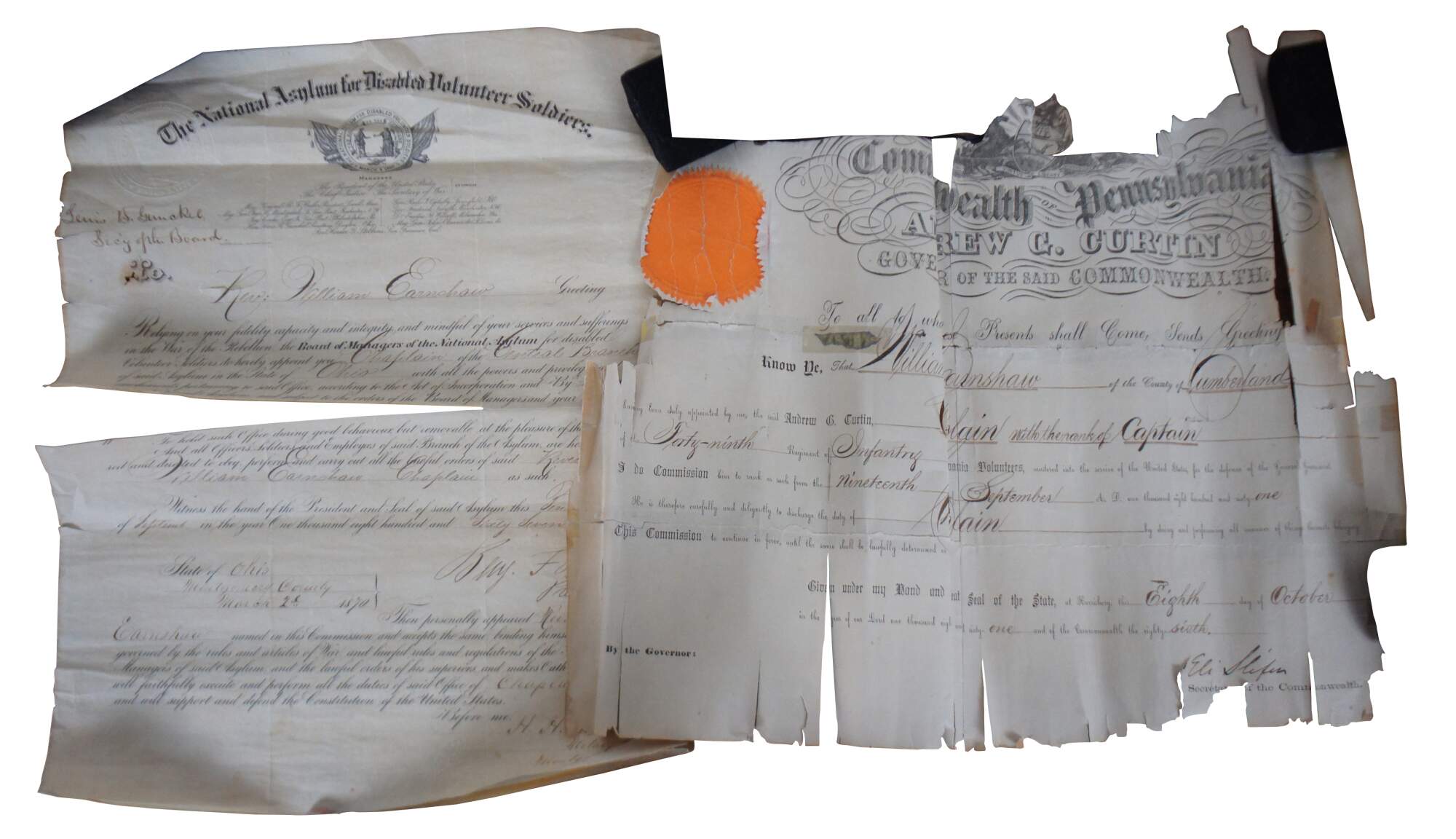
Shipping:
Free Shipping Included
Delivery:
Estimated 2-15 Business Days
Payments:
Credit Card, Check, Cash, PayPal, Apple Pay, Venmo
Returns:
30 Days 100% Money Back Guarantee, Buyer Pays Return Shipping
Description
Pair of original antique documents belonging to Reverand William Earnshaw, one representing his commission with the 49th Pennsylvania Infantry Regiment as regimental chaplain in 1861, and the other establishing him as chaplain of The National Asylum for Disabled Volunteer Soldiers in 1867.
“William Earnshaw, D.D. (April 12, 1828 – July 7, 1885) was an American minister who served in the Union Army as a chaplain and as the 8th Commander-in-Chief of the Grand Army of the Republic, 1879-1880. Earnshaw was born on April 12, 1828 in Chester, Pennsylvania. Soon after the outbreak of the Civil War, he enlisted April 16, 1861 as a private in the 49th Pennsylvania Infantry and was mustered in as the regiment's chaplain with the rank of captain. Earnshaw resigned his commission on October 12, 1862 when the regiment was consolidated with another regiment. He was appointed a hospital chaplain in the U.S. Volunteers April 22, 1863 and remained in the service until August 27, 1867. With the necessity of creating national cemeteries, Ernshaw was superintendent of the construction of Stones River National Cemetery and Nashville National Cemetery. He was elected chaplain of the National Military Home in Dayton, Ohio on September 5, 1867 and held the post until illness forced him to retire. Earnshaw was Commander of the Ohio Department, Grand Army of the Republic in 1876, Junior Vice-Commander in 1877, and presided at the national encampment of the G.A.R. in Albany, New York in 1879, when he was elected to serve as the national organization's 8th Commander-in-Chief. He died July 7, 1885 in Dayton, Ohio and is buried there in Woodland Cemetery and Arboretum.” “The 49th Pennsylvania Volunteer Infantry was an infantry regiment that served in the Union Army during the American Civil War. The 49th Pennsylvania Infantry was organized in Lewistown and Harrisburg, Pennsylvania and mustered in September 14, 1861 at Camp Curtin for a three-year enlistment under the command of Colonel William H. Irwin. The regiment was attached to Hancock's Brigade, W. F. Smith's Division, Army of the Potomac, to March 1862. 1st Brigade, 2nd Division, IV Corps, Army of the Potomac, to May 1862. 1st Brigade, 2nd Division, VI Corps, Army of the Potomac, to February 1863. 3rd Brigade, 1st Division, VI Corps, to July 1864. 3rd Brigade, 1st Division, VI Corps, Army of the Shenandoah, to August 1864. Reserve Division, Department of West Virginia, to September 1864. 3rd Brigade, 1st Division, VI Corps, Army of the Shenandoah, to December 1864, and Army of the Potomac, to July 1865. The 49th Pennsylvania Infantry mustered out July 15, 1865.” “The National Asylum for Disabled Volunteer Soldiers was established on March 3, 1865, in the United States by Congress to provide care for volunteer soldiers who had been disabled through loss of limb, wounds, disease, or injury during service in the Union forces in the American Civil War. Initially, the Asylum, later called the Home, was planned to have three branches: in the Northeast, in the central area north of the Ohio River, and in what was then considered the Northwest, the present upper Midwest.” “At the end of the Civil War, the country faced the unprecedented challenge to care for the thousands of disabled veterans who fought to preserve the union. The answer: soldiers’ homes constructed on a scale unseen in America. Among the very first was built in Dayton. The campus became not only a destination for recovering soldiers, but for patriotic tourists who came from far away to pay their respects to the veterans and take in the spectacle of the ornate architecture and grand gardens. The central branch of what became the National Home for Disabled Volunteer Soldiers on Dayton’s west side opened its gates to the first veterans in the fall of 1867, two years after the end of the Civil War.”
Condition
Fair Antique Condition - Yellowing/discoloration; various splits/creases; paper brittle
Dimensions
11.5” x 14.75” (Width x Length)